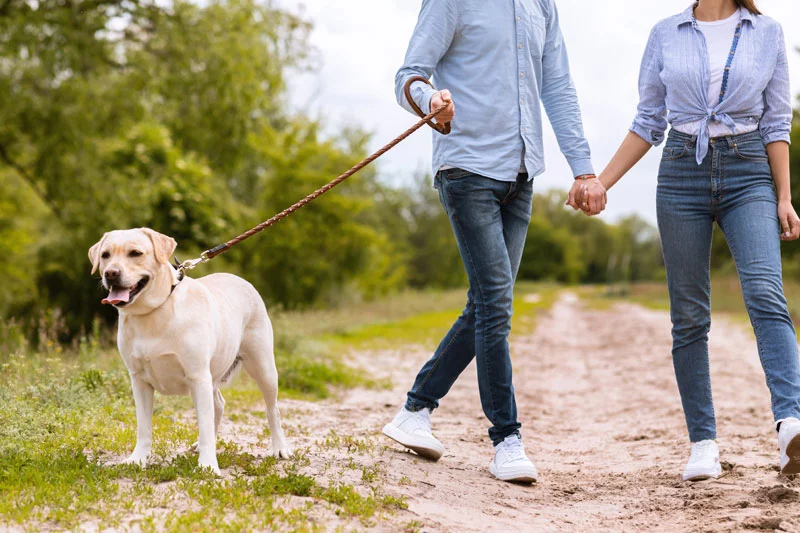You should walk your dog every day, but it is not necessary to do so.

Credit: www.pinterest.com
Importance Of Dog Walking
Dog walking is more than just a routine task; it plays a crucial role in maintaining the physical and mental well-being of your furry friend. Understanding the importance of regular walks for your dog is vital to ensure their overall health and happiness.
Mental Stimulation
Regular walks provide important mental stimulation for your dog. Exploring new scents, sights, and sounds during a walk engages your dog’s senses and keeps their mind active and alert. This mental exercise is essential for preventing boredom and reducing destructive behaviors at home.
Physical Exercise
Walking is the most natural form of exercise for dogs. It helps in maintaining a healthy weight, improving cardiovascular health, and strengthening muscles. A well-exercised dog is less likely to develop obesity-related health issues and will have improved overall endurance and stamina.
Social Interaction
When you take your dog for a walk, they have the opportunity to interact with other dogs, people, and the environment. This socialization is crucial for their emotional well-being and ensures they develop proper behavior around others. It also helps in reducing anxiety and building confidence.

Credit: shallowfordvet.com
Frequency Of Dog Walking
Walking your dog is an essential part of their physical and mental well-being. The frequency of dog walking depends on various factors, including breed, age, and individual needs. In this guide, we’ll explore the factors to consider, general recommendations, and how different breeds and ages may impact the frequency of walking.
Factors To Consider
- Breed characteristics
- Energy level of the dog
- Age and health status of the dog
- Living environment, such as urban or suburban
General Recommendations
While every dog is unique, a general rule of thumb is that most dogs benefit from at least one brisk walk every day. However, this can vary based on the factors mentioned above. It’s important to observe your dog’s behavior and adjust their walking routine accordingly.
Breeds And Age
Different breeds have different exercise needs. High-energy breeds may require more frequent and longer walks, while senior dogs may need shorter and more leisurely strolls. Puppies also need specific exercise routines based on their age and development stage.
Signs Of Inadequate Walking
- Excessive barking or whining
- Destructive behavior like chewing on furniture
- Restlessness or hyperactivity
- Obesity or weight gain
- Muscle weakness or stiffness
- Joint pain or arthritis
Expert Recommendations
When it comes to how often you should walk your dog, it’s important to consider the recommendations of experts in the field. The following guidelines from veterinary professionals and certified trainers can help you determine the ideal walking routine for your furry companion.
Veterinary Advice
Veterinarians stress the importance of regular exercise for dogs, as it promotes physical fitness, mental stimulation, and social interaction. While the frequency of walks may vary based on your dog’s age, breed, and health condition, it is generally recommended to walk your dog at least once per day.
For puppies, it’s important to start with shorter walks and gradually increase the duration as they grow. As a general rule, a puppy should have about five minutes of walking for each month of their age. For example, a three-month-old puppy can handle about 15 minutes of walking.
Adult dogs usually benefit from more extended walks, typically around 30 minutes to an hour. However, this can vary based on factors such as breed, size, and energy level. High-energy breeds may require more exercise, while smaller or less active breeds may be content with shorter walks.
Certified Trainers’ Guidelines
Certified dog trainers often recommend an hour-long walk every day as a good starting point. However, they advise that specific needs may differ based on your dog’s individual characteristics. For example, larger breeds or working dogs may require more exercise to satisfy their physical and mental needs.
It’s also essential to consider other forms of mental and physical stimulation, such as playtime and interactive toys, in addition to regular walks. This variety helps prevent boredom and promotes a well-rounded lifestyle for your canine companion.
In Conclusion
While expert recommendations are valuable, it is crucial to remember that every dog is unique. Pay attention to your dog’s behavior and energy levels to determine if they need more or less exercise. Consulting with your veterinarian and observing your dog’s response to different walking routines will help you find the perfect balance for their overall well-being.
Customized Walking Plans
Walking your dog is not just a physical activity; it’s also a mental and social exercise that provides them with the opportunity to explore and stay active. The frequency and duration of your dog’s walks should be customized based on various factors, including their age, health, and breed. A customized walking plan ensures that your dog gets the right amount of exercise and stimulation to keep them healthy and happy. Let’s dive deeper into creating customized walking plans for different scenarios.
Puppy Walking Plan
For puppies, it’s essential to start with short, frequent walks to gradually build their strength and endurance. Puppies generally require multiple shorter walks throughout the day, typically around five minutes per month of age, spread out across the day. As they grow, you can gradually increase the duration of their walks. It’s crucial to avoid overexerting them, as their joints and muscles are still developing. Additionally, socialization during walks is vital for their overall behavioral development.
Energetic Breed Walking Plan
Energetic breeds such as Border Collies and Labrador Retrievers require more vigorous and longer walks to burn off their excess energy. These dogs benefit from engaging activities, so consider incorporating mental stimulation and interactive play during their walking sessions. An hour-long walk every day is generally a good recommendation for such breeds. Ensuring that they have plenty of opportunities to explore and engage in physical and mental activities will help keep them content and balanced.
Dog Walking Best Practices
Walking your dog is essential for their mental and physical well-being. While it’s generally recommended to take your furry friend for a walk every day, it’s not necessary to do so religiously. Skipping a walk occasionally is okay, but consistent exercise and mental stimulation are crucial for preventing behavioral problems.
Ideal Walk Duration
For optimal health benefits, aim for around an hour-long walk daily, catering to your dog’s breed and age.
Appropriate Walking Times
Consider your dog’s activity level; most dogs benefit from multiple walks throughout the day, ensuring physical and mental stimulation.
Include table if necessary
Walking your dog provides crucial mental stimulation, exercise, and social interaction.
- Skipping a walk occasionally is acceptable, but consistency is key.
- Longer walks allow exploration and fulfill your dog’s need to roam.
- Outdoor walks reduce boredom and prevent destructive behavior.
Meeting your dog’s walking needs contributes to their overall well-being, emphasizing a balanced routine.
Dog Walking Faqs
Regular dog walking is essential for their physical and mental well-being. While it’s recommended to walk your dog every day, it’s not necessary to do so. Skipping a walk occasionally is okay, but make sure to provide alternative ways to stimulate and exercise your furry friend.
Calculating Walking Duration
When calculating the duration of your dog’s walk, consider the breed, size, and age of your dog. A general guideline is that smaller breeds may only require around 20-30 minutes, while larger or more active breeds might benefit from 1-2 hours of walking per day to meet their exercise needs.
Toilet Break Considerations
Understanding your dog’s toilet needs is crucial for a successful walking routine. On average, dogs require a toilet break every 4-6 hours. Puppies and senior dogs may need more frequent breaks, possibly every 2-3 hours, while adult dogs may only need to relieve themselves 3-5 times a day.
Nighttime Walking
When considering nighttime walking, safety should be a priority. Ensure that the walking area is well-lit and free from hazards. Additionally, check local regulations and consider using reflective gear to improve visibility. Dogs may need shorter walks at night to meet their bathroom needs, but avoid disrupting their regular sleep patterns.
Credit: www.quora.com
Frequently Asked Questions
Is It Ok Not To Walk Your Dog Everyday?
Yes, it is okay to skip a dog walk occasionally. Regular walks are important for mental stimulation and exercise, but daily walks are not mandatory.
How Many Walks A Day Does My Dog Need?
Dogs need at least one to two walks per day for mental stimulation and exercise. Some may enjoy longer walks.
How Often Should An Indoor Dog Be Walked?
An indoor dog should be walked at least once a day, but more frequent walks may be beneficial based on the dog’s energy level and breed requirements.
What Happens If You Don’t Walk Your Dog Enough?
Not walking your dog enough can lead to behavioral problems, such as destructive behavior. Dogs need exercise and mental stimulation, especially high-energy breeds. Lack of outdoor exercise can make them bored and frustrated. Aim for at least one to two walks per day, depending on your dog’s needs.
Conclusion
Regular walks are vital for your dog’s well-being, providing exercise, mental stimulation, and social interaction. While daily walks are beneficial, it’s okay to skip occasionally. The frequency and duration should suit your dog’s breed, age, and energy level. Remember, a happy and healthy pup is a well-exercised pup.



